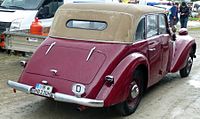Hansa 2000
| Hansa / Borgward | |
|---|---|
|
Hansa 2000 (1937-1938)
|
|
| 2000/2300 | |
| Production period: | 1937-1942 |
| Class : | upper middle class |
| Body versions : | Sedan , convertible sedan , convertible |
| Engines: |
Petrol engines : 2.0-2.3 liters (38-40 kW) |
| Length: | 4500 mm |
| Width: | 1600 mm |
| Height: | 1540 mm |
| Wheelbase : | 2880 mm |
| Empty weight : | 1260 kg |
The Hansa 2000 is an upper middle class vehicle from Carl FW Borgward , who had been the sole owner of the automobile factory in Bremen-Sebaldsbrück since September 1937 . The car was later renamed Borgward 2000 and shortly afterwards replaced by the Borgward 2300 .
history
The prototype was presented in February 1937, series production began that same year, according to other sources not until 1938.
From the beginning of October 1939, a version with a 2.3-liter engine was offered, which replaced the 2.0-liter model. This was the only car model that Borgward was still allowed to manufacture at that time, as the Schell Plan only allowed the company to manufacture a heavy type of car with a displacement between 2.0 and 3.0 liters. In 1942 production was discontinued without replacement due to the war.
Engine, transmission and chassis
The six-cylinder in-line engine of the Hansa 2000 / Borgward 2000 made 48 hp (35 kW) at 3800 rpm and a compression ratio of 6: 1. With a bore of 70 mm and a stroke of 85 mm, the displacement was 1962 cm³. The engine had overhead valves, which were operated by a side camshaft driven by spur gears via bumpers and rocker arms ( OHV valve control ), as well as a single carburetor of the type Solex 30 BFRH .
From 1939 the engine of the Borgward 2300 had a displacement of 2247 cm³ (bore × stroke = 72 mm × 92 mm) and made 55 hp (40 kW) at 3800 rpm. Compression and carburetor remained unchanged.
The maximum speed of all body variants of the Hansa 2000 / Borgward 2000 was 115 km / h, the Borgward 2300 was up to 120 km / h.
All cars had a four-speed gearbox with a center lever, also known as a stick shift. Gears two to four were synchronized. The rear wheels were driven.
The body was built on a “central frame” forked at the front and rear, a box frame with closely spaced longitudinal support tubes with cross members. The front wheels were individually suspended on two transverse leaf springs , the rear pendulum swing axle only had one transverse leaf spring. There were hydraulically operated drum brakes on all 4 wheels ; the handbrake worked on the rear wheels. The cars had central lubrication .
The cars accelerated from 0 to 100 km / h in 32 seconds. Their fuel consumption was 12.5 liters per 100 km.
Bodies
All three types were available as four-door sedans or four-door convertibles , the doors of which were hinged on the B-pillars - that is, the front rear and the rear front. The two-door convertible had two rear-hinged doors. The streamlined bodies had a rearward curved grille between the rocket-shaped headlights. The fenders were pulled back with a swing; the front ended at the A-pillars , the rear in a flat tail.
Gallery images
Individual evidence
- ↑ a b c d e f g h i j k l m Werner Oswald : Deutsche Autos 1920–1945 . Motorbuch Verlag, Stuttgart 1996. 10th edition. ISBN 3-87943-519-7 . P. 155.
- ↑ Werner Oswald: German Cars 1920–1945 . Motorbuch Verlag, Stuttgart 1996. 10th edition. ISBN 3-87943-519-7 . P. 154.
- ^ Georg Schmidt: Borgward - Carl FW Borgward and his cars . Motorbuch Verlag, Stuttgart 1982. 3rd edition. ISBN 3-87943-679-7 . P. 71.
- ↑ a b c Werner Oswald: German Cars 1920–1945 . Motorbuch Verlag, Stuttgart 1996. 10th edition. ISBN 3-87943-519-7 . Pp. 154-155.
- ^ Georg Schmidt: Borgward - Carl FW Borgward and his cars . Motorbuch Verlag, Stuttgart 1982. 3rd edition. ISBN 3-87943-679-7 . P. 82.
- ↑ http://oldtimer-freunde-wernshausen.de/?Restauration/Aktuell-Hansa-2000





